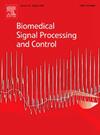Effective muscle synergies extraction pipeline to characterise the Box and Block Test movement
IF 4.9
2区 医学
Q1 ENGINEERING, BIOMEDICAL
引用次数: 0
Abstract
The Box and Block test (BBT) is a clinical test for the evaluation of the unilateral manual dexterity. To the best of our knowledge, no study has yet explored it through the muscle synergy approach. Since each analysis step impacts on the muscle synergies influencing the results interpretation, this study aims at i) optimising the procedure of muscular synergies extraction in BBT and ii) applying it to characterise BBT in healthy individuals. Electromyographic (EMG) data (8 muscles per arm) were recorded from 16 participants during the BBT performed with each upper limb, separately. Muscle synergies were extracted by means of the Non-Negative Matrix Factorization method and the impact of following two parameters was estimated: (i) cut-off frequency of low-pass filter designed to compute the envelope of the EMG signals (ii) type of normalisation to be applied to the EMG envelopes. Results show that the procedure of muscular synergies extraction requires to be optimised with particular attention to the cut-off frequency of low-pass filter designed to compute the envelope of the EMG signals and the type of normalisation to be applied to the EMG envelopes. From the physiological perspective, three synergies seem to be enough to capture main BBT movement mechanisms. The evaluation of the impact of processing steps on the muscle synergies and the characterization of the BBT will pave the way for the definition of a standard procedure to be applied also in a pathological context.
有效的肌肉协同作用提取管道,以表征框和块测试运动
盒块试验(BBT)是一种评估单侧手灵巧度的临床试验。据我们所知,还没有研究通过肌肉协同作用的方法来探索它。由于每个分析步骤都会影响肌肉协同作用,从而影响结果的解释,因此本研究旨在i)优化BBT中肌肉协同作用的提取过程,ii)将其应用于健康个体的BBT特征。在BBT期间,分别记录16名参与者的肌电图(EMG)数据(每只手臂8块肌肉)。通过非负矩阵分解方法提取肌肉协同效应,并估计以下两个参数的影响:(i)设计用于计算肌电信号包络的低通滤波器的截止频率(ii)应用于肌电信号包络的归一化类型。结果表明,肌肉协同作用的提取过程需要优化,特别注意用于计算肌电信号包络的低通滤波器的截止频率和应用于肌电信号包络的归一化类型。从生理学的角度来看,三种协同作用似乎足以捕捉主要的BBT运动机制。评估处理步骤对肌肉协同作用的影响以及BBT的特征将为标准程序的定义铺平道路,该标准程序也适用于病理背景。
本文章由计算机程序翻译,如有差异,请以英文原文为准。
求助全文
约1分钟内获得全文
求助全文
来源期刊

Biomedical Signal Processing and Control
工程技术-工程:生物医学
CiteScore
9.80
自引率
13.70%
发文量
822
审稿时长
4 months
期刊介绍:
Biomedical Signal Processing and Control aims to provide a cross-disciplinary international forum for the interchange of information on research in the measurement and analysis of signals and images in clinical medicine and the biological sciences. Emphasis is placed on contributions dealing with the practical, applications-led research on the use of methods and devices in clinical diagnosis, patient monitoring and management.
Biomedical Signal Processing and Control reflects the main areas in which these methods are being used and developed at the interface of both engineering and clinical science. The scope of the journal is defined to include relevant review papers, technical notes, short communications and letters. Tutorial papers and special issues will also be published.
 求助内容:
求助内容: 应助结果提醒方式:
应助结果提醒方式:


